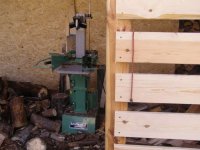BHD
Veteran Member
on my log splitter, I made a power pack, engine pump and tank valve and two quick fittings, (I did use the log splitter pump with the High and low in it),
and set it off to the side of the I beam, (bolted on) and plug into the cylinder, and have used it for other hydraulic needs I many have,
used it for a wire roller, a winch, could use it to lift machinery and pull it with a non hydraulic power unit, like a pickup, I have some Ideas for a super shop press some time.
but it may give some versatility,
my son in law used a electric log splitter, and liked it very much, he like the lack of noise, and could run it at night with out up setting neighbors, or may be it was the built in beverage holder, I don't know for sure, but he was impressed with it.
It used a 2 HP motor,
and set it off to the side of the I beam, (bolted on) and plug into the cylinder, and have used it for other hydraulic needs I many have,
used it for a wire roller, a winch, could use it to lift machinery and pull it with a non hydraulic power unit, like a pickup, I have some Ideas for a super shop press some time.
but it may give some versatility,
my son in law used a electric log splitter, and liked it very much, he like the lack of noise, and could run it at night with out up setting neighbors, or may be it was the built in beverage holder, I don't know for sure, but he was impressed with it.
It used a 2 HP motor,
Last edited:
